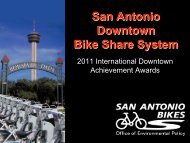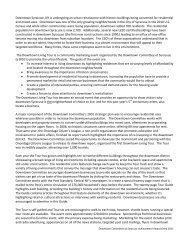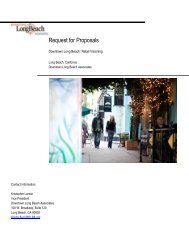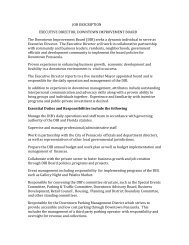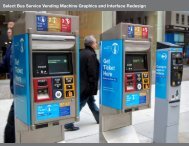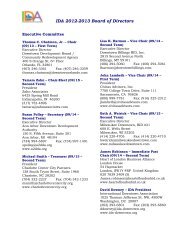The Value of Investing in Canadian Downtowns - International ...
The Value of Investing in Canadian Downtowns - International ...
The Value of Investing in Canadian Downtowns - International ...
Create successful ePaper yourself
Turn your PDF publications into a flip-book with our unique Google optimized e-Paper software.
STRATEGY<br />
Is the City Strategically <strong>Invest<strong>in</strong>g</strong> <strong>in</strong> Its Future?<br />
Approach to Municipal Investments<br />
<strong>The</strong> City <strong>of</strong> Toronto has been mov<strong>in</strong>g forward on many capital projects <strong>in</strong> the downtown, yet the value <strong>of</strong> these<br />
projects can be difficult to quantify as over 90% <strong>of</strong> the City’s proposed Capital Budget is assigned to citywide<br />
projects. Overwhelm<strong>in</strong>gly these ‘citywide projects’ relate to broad <strong>in</strong>vestments such as technology upgrades, fleet<br />
upgrades, waste system improvements, sewers and <strong>in</strong>vestment <strong>in</strong> utilities. Yet some citywide <strong>in</strong>vestments do relate<br />
to the downtown study area, for example the ‘Waterfront Revitalization Initiative’ has been a key focus <strong>of</strong> City<br />
<strong>in</strong>vestment, as well as the Pan Am Games Athletes’ Village.<br />
<strong>The</strong> rema<strong>in</strong>der <strong>of</strong> the proposed budget (around 10%) is classified by ward, allow<strong>in</strong>g downtown <strong>in</strong>vestments to be<br />
viewed separately. In this context, the downtown fares well with relatively high levels <strong>of</strong> proposed <strong>in</strong>vestment <strong>in</strong> 2010<br />
to 2012 compared to other parts <strong>of</strong> the City. Yet it should be noted that over 60% <strong>of</strong> this proposed <strong>in</strong>vestment is to be<br />
spent on Union Station, which will benefit the entire Toronto region. Other key <strong>in</strong>vestments downtown <strong>in</strong>clude the<br />
Regent Park redevelopment and the Nathan Phillips Square upgrade.<br />
$300,000<br />
$250,000<br />
$200,000<br />
$150,000<br />
$100,000<br />
$50,000<br />
$-<br />
Proposed Capital Investment <strong>in</strong> City <strong>of</strong> Toronto by Wards 2010-2012<br />
Etobicoke (Wards 1-6) York (Wards 7-12) Inner North, East and Downtown (Wards 20,<br />
West (Wards 13-19, 21- 27, 28)<br />
26, 29-34)<br />
Scarborough (Wards<br />
35-44)<br />
2010<br />
2011<br />
2012<br />
Data Collection Process<br />
From the outset it is important to acknowledge that the project team faced significant challenges <strong>in</strong> the compilation <strong>of</strong><br />
a complete set <strong>of</strong> Capital Projects Data for the City <strong>of</strong> Toronto. <strong>The</strong>refore, the team utilized a methodology to present<br />
capital projects data that differs from the other case studies. To develop the capital projects map the team utilized<br />
build<strong>in</strong>g permit data for the past 10 years from the City’s Open Data site (toronto.ca/open). <strong>The</strong> team then sorted<br />
downtown <strong>in</strong>vestments by postal code and identified the value <strong>of</strong> build<strong>in</strong>g permits issued for traditional public sector<br />
<strong>in</strong>vestments such as libraries, arenas, perform<strong>in</strong>g arts centres, sports complexes and facilities, as the basis <strong>of</strong> capital<br />
expenditure. This list <strong>of</strong> build<strong>in</strong>g permits <strong>in</strong>cluded construction values and addresses but it did not <strong>in</strong>clude the name<br />
<strong>of</strong> the facility that received improvement, so the team searched through the addresses on Google Earth to identify<br />
name <strong>of</strong> the name <strong>of</strong> the facility where the <strong>in</strong>vestment was made (<strong>in</strong> a handful <strong>of</strong> <strong>in</strong>stances this could not be<br />
determ<strong>in</strong>ed). Additionally there are several <strong>in</strong>vestments located on the boundary <strong>of</strong> the downtown; these have been<br />
<strong>in</strong>cluded as this has been the approach applied across the other case studies.<br />
This data has some limitations as it fails to capture <strong>in</strong>vestments be<strong>in</strong>g made that do not trigger build<strong>in</strong>g permits such<br />
as social programs, small-scale public realm upgrades and/or undertak<strong>in</strong>g a detailed plann<strong>in</strong>g process. Moreover,<br />
this approach fails to account for the municipal proportion <strong>of</strong> <strong>in</strong>vestment; rather it captures the total value <strong>of</strong> the<br />
capital <strong>in</strong>vestment. However given the data limitations faced, this approach is considered optimal for ga<strong>in</strong><strong>in</strong>g a<br />
94






